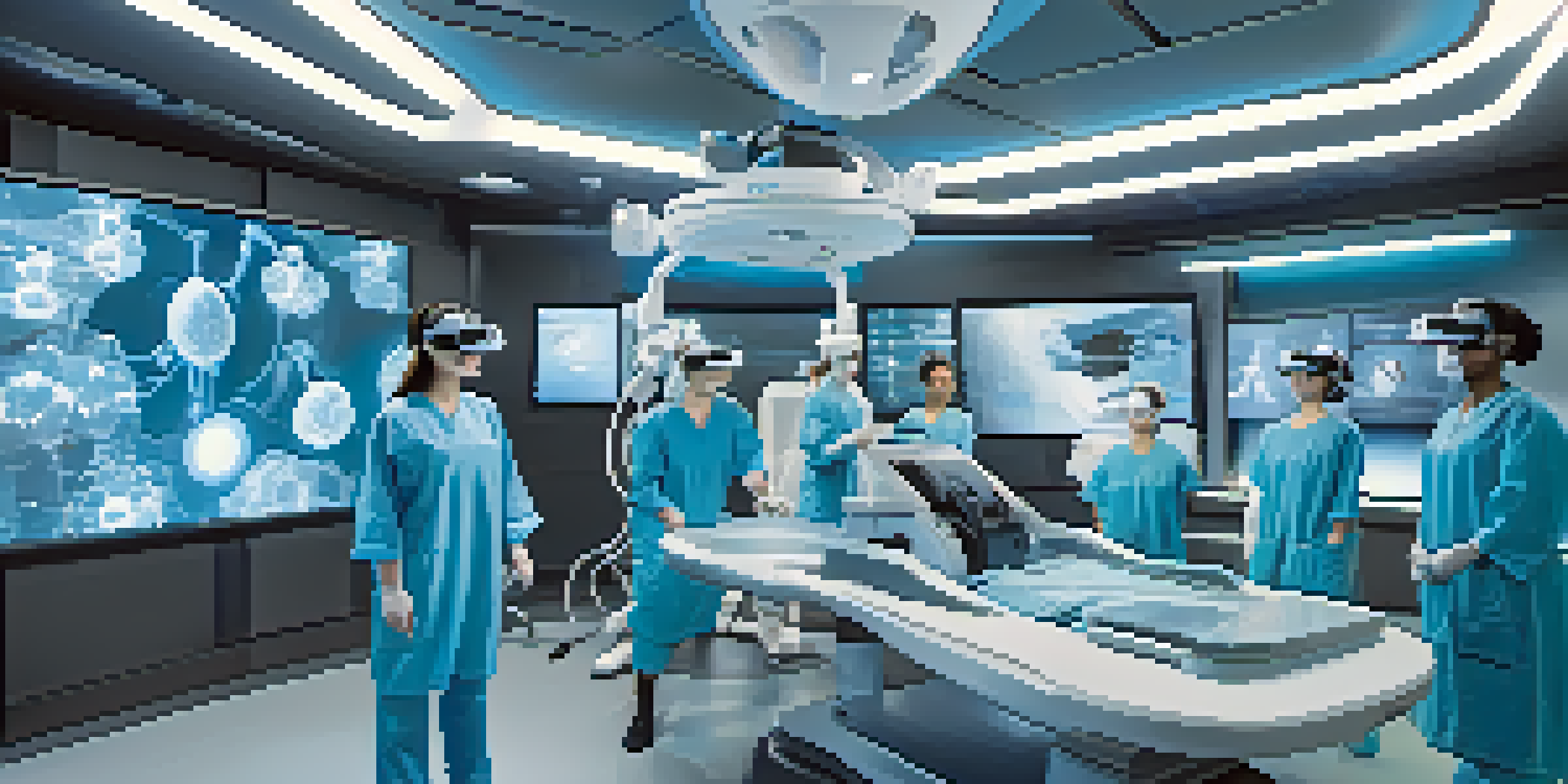The Role of VR in Training and Skill Development

Understanding Virtual Reality and Its Basics
Virtual Reality (VR) immerses users in a computer-generated environment, simulating real-world experiences. This technology is not just about gaming; it has practical applications in various fields, including training and education. By donning a VR headset, users can interact with a 3D space that replicates scenarios they may encounter in their jobs or daily life.
Virtual reality allows us to experience things we could never experience in real life.
Think of VR as a high-tech training ground where you can practice skills without real-world consequences. For instance, a surgeon can perform surgeries in a virtual environment before ever touching a patient. This hands-on experience allows for mistakes and learning in a controlled setting, significantly enhancing skill retention.
As VR technology continues to evolve, its accessibility and affordability are improving, making it a viable option for businesses and educational institutions. The potential for immersive learning experiences can transform traditional training methods, leading to more effective skill development.
Enhancing Learning Through Immersive Experiences
Immersive learning is at the heart of VR's effectiveness in training. By engaging multiple senses, VR creates a more compelling experience that can boost motivation and retention. Imagine learning to drive in a virtual car that responds just like a real one; this kind of simulation helps learners grasp complex concepts faster.

Studies show that learners retain information better when actively engaged rather than passively receiving it. In a VR setting, users can experiment, make decisions, and receive instant feedback, all of which enhance the learning process. This interactive approach mirrors real-life challenges, preparing individuals more effectively for their roles.
VR Transforms Training Methods
Virtual Reality creates immersive, interactive experiences that enhance skill development and retention across various industries.
Moreover, VR can tailor learning experiences to individual needs, allowing users to progress at their own pace. This adaptability is particularly beneficial in diverse workforces where employees have varying levels of experience and learning styles.
Real-World Applications of VR in Training
Various industries are harnessing VR to revolutionize their training protocols. For example, the healthcare sector employs VR simulations to train medical professionals in complex procedures. This practical application not only enhances skill development but also improves patient safety by ensuring practitioners are well-prepared.
The future of education is not about the content, but the experience.
Similarly, the aviation industry uses VR for pilot training, allowing trainees to experience flying without the risks associated with real-life flight. These simulations can replicate challenging weather conditions or emergency scenarios, providing pilots with valuable experience before they take to the skies.
In corporate environments, VR is being used for employee onboarding and skills training. Companies can create tailored scenarios that reflect their specific challenges, fostering a more engaged and knowledgeable workforce. This practical approach can lead to quicker ramp-up times and improved employee performance.
Cost-Effectiveness of VR Training Solutions
While the initial investment in VR technology may seem high, the long-term benefits can outweigh costs. Traditional training methods often involve travel expenses, materials, and time away from the job. VR can significantly reduce these costs by allowing training to occur in-house and on-demand.
Additionally, VR training can lead to faster learning and reduced error rates, ultimately saving companies money. For instance, a manufacturing firm that uses VR to train employees on machinery can minimize downtime and decrease the likelihood of costly mistakes.
Cost-Effective Training Solutions
Investing in VR technology can lead to significant long-term savings by reducing travel and material costs associated with traditional training.
As VR technology becomes more mainstream, the cost of development and implementation is decreasing. Companies that invest in VR training solutions can position themselves as innovative leaders in their industries while also reaping financial rewards.
Overcoming Challenges in VR Training Implementation
Despite its numerous benefits, implementing VR training solutions does come with challenges. One significant hurdle is the initial setup, which can involve hardware costs, software development, and employee training. Companies must also ensure they have the infrastructure to support VR technology.
Another challenge is user adaptation; not everyone is comfortable using VR, and some may experience motion sickness or discomfort. Providing adequate training and support can help ease this transition, ensuring that all employees feel confident in using the technology.
Moreover, continuous content updates are necessary to keep training relevant and engaging. Organizations must commit to regularly reviewing and enhancing their VR training programs to align with industry changes and employee needs.
The Future of VR in Skill Development
As technology advances, the future of VR in training looks promising. Innovations such as augmented reality (AR) and artificial intelligence (AI) are beginning to blend with VR, creating even more immersive training experiences. This fusion can provide personalized learning paths, adapting to individual progress and preferences.
Moreover, the increasing availability of VR tools means that more organizations, regardless of size, can leverage this technology. As VR becomes more integrated into mainstream training practices, we can expect a cultural shift towards accepting and valuing immersive learning methods.
Future of Training is Immersive
The integration of VR with technologies like AR and AI promises to further enhance personalized learning experiences for diverse industries.
Looking ahead, we can anticipate a broader range of industries adopting VR for training, from retail to construction. This expansion will not only enrich the training landscape but also enhance overall workforce competency and adaptability.
Conclusion: Embracing VR for Effective Training
In conclusion, virtual reality is redefining the landscape of training and skill development. By providing immersive, interactive experiences, VR enables learners to practice skills in a safe environment, leading to better retention and performance. Its applications across various industries demonstrate its versatility and effectiveness.
As organizations begin to embrace VR technology, they must consider the long-term benefits it offers, including cost savings and enhanced employee engagement. By investing in VR training solutions, companies can foster a culture of continuous learning and innovation.

Ultimately, the future of training lies in immersive experiences that prepare individuals for real-world challenges. By adopting VR, organizations can ensure their workforce is not only skilled but also ready to adapt to a rapidly changing environment.